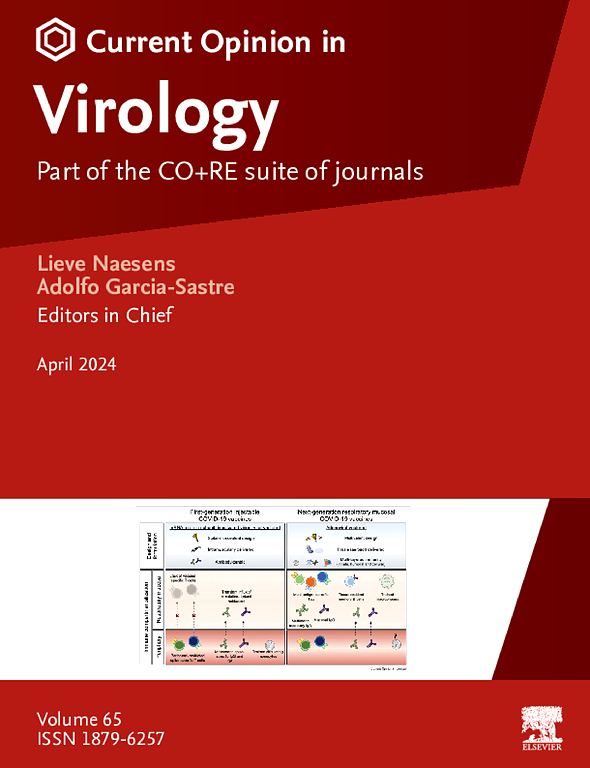人类t细胞白血病病毒I型:病毒基因表达的调节和宿主信号通路的扰动导致持续感染
IF 5.1
2区 医学
Q1 VIROLOGY
引用次数: 0
摘要
人类t细胞白血病病毒I型(HTLV-1)是第一个被发现的人类致病性逆转录病毒。HTLV-1诱导t细胞恶性肿瘤、成人t细胞白血病淋巴瘤(ATL)和炎症性疾病,如HTLV-1相关脊髓病(HAM)、HTLV-1葡萄膜炎(HU)和HTLV-1相关肺部疾病(HAPD)。重要的是,HTLV-1通过调节病毒基因表达和破坏宿主信号通路来维持持续感染,这些活动与它的致病性密切相关。HTLV-1通过调节包括tax和HTLV-1 bZIP因子(HBZ)在内的病毒基因的表达,使自身能够逃避宿主免疫攻击并促进被感染细胞的克隆扩增。此外,HTLV-1还干扰宿主信号通路,如转化生长因子(TGF)-β信号通路、IL-10/JAK/STAT信号通路、核因子- κ B信号通路、Wnt信号通路、Rb/E2F信号通路等。在这些途径中,前两种途径最近被证明在ATL的发展中具有重要意义。HBZ增强TGF-β信号通路的激活和免疫抑制细胞因子IL-10的产生,这些活性不仅有助于病毒逃避宿主免疫系统,而且有助于htlv -1感染细胞本身的增殖。此外,HBZ可将htlv -1感染的细胞转化为treg样细胞,进一步提高其存活率。总之,HTLV-1通过调节病毒基因表达和破坏宿主信号通路,促进被感染细胞在体内的长期存活,从而加速HTLV-1相关疾病的发展。本文章由计算机程序翻译,如有差异,请以英文原文为准。
Human T-cell leukemia virus type I: modulation of viral gene expression and perturbation of host signaling pathways lead to persistent infection
Human T-cell leukemia virus type I (HTLV-1) was the first human pathogenic retrovirus to be discovered. HTLV-1 induces a T-cell malignancy, adult T-cell leukemia-lymphoma (ATL), and inflammatory diseases, such as HTLV-1-associated myelopathy (HAM), HTLV-1 uveitis (HU), and HTLV-1-associated pulmonary disease (HAPD). Importantly, HTLV-1 maintains persistent infection by regulating viral gene expression and disrupting host signaling pathways — activities that are closely linked to its pathogenicity. By modulating the expression of viral genes, including tax and HTLV-1 bZIP factor (HBZ), HTLV-1 enables itself to evade host immune attack and to promote the clonal expansion of infected cells. In addition, HTLV-1 perturbs host signaling pathways, such as the transforming growth factor (TGF)-β signaling pathway, the IL-10/JAK/STAT signaling pathway, the nuclear factor-kappa B signaling pathway, the Wnt signaling pathway, and the Rb/E2F signaling pathway. Among these pathways, the first two have recently been demonstrated to be significant in the development of ATL. HBZ enhances the activation of the TGF-β signaling pathway and the production of an immunosuppressive cytokine, IL-10, activities which not only help the virus evade the host immune system but also contribute to the proliferation of HTLV-1–infected cells themselves. In addition, HBZ converts HTLV-1–infected cells into Treg-like cells, which further enhances their survival. Overall, HTLV-1 promotes the long-term survival of infected cells in vivo by regulating viral gene expression and disrupting host signaling pathways, thereby accelerating the development of HTLV-1-associated disease.
求助全文
通过发布文献求助,成功后即可免费获取论文全文。
去求助
来源期刊

Current opinion in virology
VIROLOGY-
CiteScore
11.80
自引率
5.10%
发文量
76
审稿时长
83 days
期刊介绍:
Current Opinion in Virology (COVIRO) is a systematic review journal that aims to provide specialists with a unique and educational platform to keep up to date with the expanding volume of information published in the field of virology. It publishes 6 issues per year covering the following 11 sections, each of which is reviewed once a year: Emerging viruses: interspecies transmission; Viral immunology; Viral pathogenesis; Preventive and therapeutic vaccines; Antiviral strategies; Virus structure and expression; Animal models for viral diseases; Engineering for viral resistance; Viruses and cancer; Virus vector interactions. There is also a section that changes every year to reflect hot topics in the field.
 求助内容:
求助内容: 应助结果提醒方式:
应助结果提醒方式:


